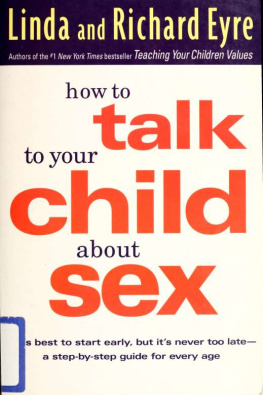This book made available by the Internet Archive.
Special thanks to the two people
writers can't exist without
an agent and an editor.
We're fortunate to have the best of both:
Jan Miller and Bob Asahina.
''American kids are in the midst of their own sexual revolution, one leaving many parents feeling confused and virtually powerless."
Time, June 15, 1998
Digitized by the Internet Archive in 2010
http://www.archive.org/details/howtotalktoyourcOOeyre
When our book Teaching Your Children Values jumped to the number one spot on The New York Times best-seller list in 1993, we realized just how profoundly concerned parents are about the values their children are growing up with. And ever since thenas chapter 6 of that book, the chapter on sexual values, continued to produce the most interest, the most response, the most letters, and the most gratitude from readerswe have grown to believe that the subject of sex and the whole issue of teaching sexual responsibility and restraint may be the single greatest challenge that parents face today.
Today, as front page headlines prompt questions from our childrenquestions we may not be ready for, with answers our kids may not be ready forthe challenge is intensified. And what we need is not a set of simplified or "quick fix" answers. We need an offense rather than a defense, an integrated approach that helps children deal not only with the headlines, but with the big choices coming up in their own lives.
Our discussions with parents around the world, ranging from individual one-on-one conversations to question-and-answer sessions in large lecture halls, have convinced us that parents want and need practical, usable help. They want to know how to talk to their kids about sex in a positive, pragmatic way, and they want reassurance that their voice and their influence can outweigh that of the media and the peer group.
That's what we've tried to provide in this book. The bulk of it is actual "model dialogues" or sample discussions to use with your child concerning various aspects of sex and human intimacy, with the centerpiece being the "big talk" that we suggest for age eight. This pivotal discussion at eight is preceded by preparatory dialogues and followed by discussions designed to continue all through adolescence, each adaptable to your situation, your personality, and the age of your child.
The Mechanics and the Morality
The difficulty in writing a book about talking to our children about sex is that attitudes and opinions vary so widely about what is appropriate, right, and best in terms of sexual standards for both adults and children. Here is the approach we have taken and the reason for it:
In the dialogues and discussions we have constructed for this book, we have attempted to do two separate but connected things: First, give a clear model for explaining the mechanics and the facts to kids, and, second, extend most of the dialogues to include how beautiful and awesome sex can be when it happens in a committed, loyal, exclusive-love relationship. Whether you interpret that situation as marriage or as some other form of commitment is up to you. And if you choose to talk to your child only about the physical facts and mechanics of sex, you can leave out the second element of each dialogue altogether.
With this individual flexibility in mind, we decided that, if we do err, it should be on the conservative or protective side. After all, it's easier for a parent to leave out part of a dialogue than to add something in. Therefore, we've tried to give enough of the second element to satisfy the most protective parent so that each parent can find and use what he or she needs. And it is remarkable how conservative most parents are when it comes to their hopes and desires for their kids. A growing number hope for abstinence until marriage even if that wasn't the case in their own lives. Short of that, most parents at least want the kind of restraint that provides safety and deferment until real commitment and maturity.
So... don't thumb through the book and conclude that it is too conservative (or too liberal or too far right or too far left or too spiritual or too secular). It is what you want it to he. The dialogues are adaptable to your beliefs.
And allow for the possibility that your own beliefs and convictions about what is right and what is best for your child (and for yourself) might change as you read and contemplate, and particularly as you talk with your child. This book is written to give you options and to give you tools because you have the power, more than any other person on the planet, to know what is best for your child. The purpose of this book is to help you discover what that is and to succeed in teaching it.
Themes
Certain themes weave themselves throughout this book. The first two represent opposite approaches to most of what has been written about kids and sex over the last decade. What we read on the subject usually centers on bigness and fear. Bigness concerns the size of the problem, the huge scope, vast expense, and widespread risk of adolescent sex and teen pregnancy, and the need for broad government, legal, or educational solutions. The fear centers on the danger of promiscuity. It includes attempts to make kids aware enough (and scared enough) of the risks involved that they become more sexually responsible.
This book takes the opposite approaches of smallness and love.
Smallness: For parents, the concern is intimate and close to homeone child, their child, making good decisions and maximizing his or her chance for real love and lasting happiness. This book focuses on the interchange between individual parents and individual children. Words like ''personal," "intimate," and "individual" are used frequently to remind us of this perspective.
Love: The best (and most effective) reason for sexual restraint and responsibility is that it increases one's chances for a successful and lasting long-term commitment and for a safe and happy family. A child with this goal, this hope, this vision will make better decisions in every area of his or her life. The adjectives ''beautiful" and "awesome" are used repeatedly to symbolize this positive approach. The single greatest protection for kids (and the strongest motivation for avoiding early, dangerous sex) is to grow up thinking of sex as a wonderful, spectacular miracle that not only makes babies but also can bind couples and families together in a loyal, happy way. The words "beautiful and awesome" will come to represent this to your child.
We've taken these approaches because we feel that changing the micro is what changes the macro, and what we want to happen is stronger motivation than what we don't want to happen. We believe that love is the only force stronger than fear and that each strengthened family makes the world a slightly better and more beautiful place.

















